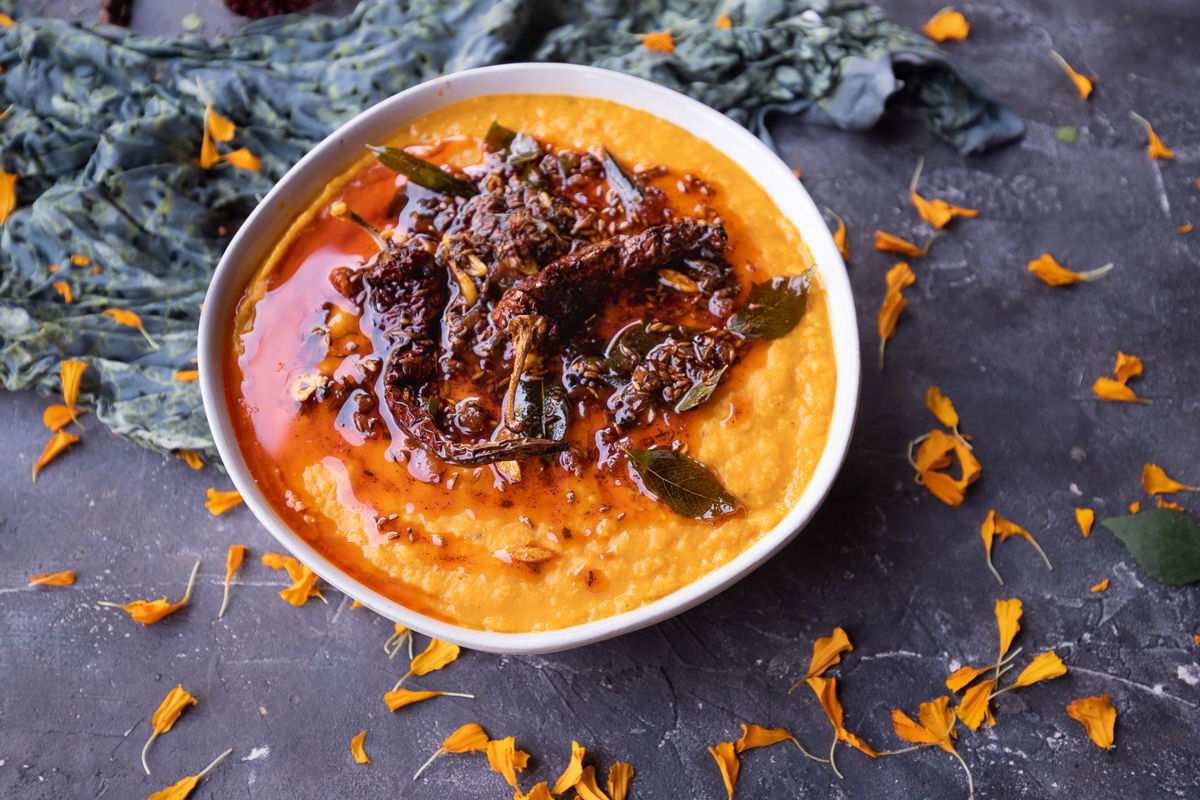If you ask any Gujarati about undhiyu, don’t be surprised if their eyes light up. Undhiyu is what brings families together when the weather turns cold and the farms overflow with hearty vegetables. It’s the centerpiece of weddings and Uttarayan feasts. It’s what you eat with puri and matho, surrounded by people you love.
Every Gujarati family has their version. And they’ll all tell you theirs is the best.

My family undhiyu is, strangely enough, Surti Undhiyu, which my mom learned from a neighbor when she was newly married. This is the dish she made for us every winter growing up. The one I make now for my own family.
Although I have made my own changes to it. This is the version I have adapted for the Instant Pot, because that’s what works in my kitchen today. With sweet potatoes soaked in masala, stuffed eggplants that melt in your mouth, papdi beans, and those soft, spiced muthiya that we always fight over. The heart of the dish is the same.
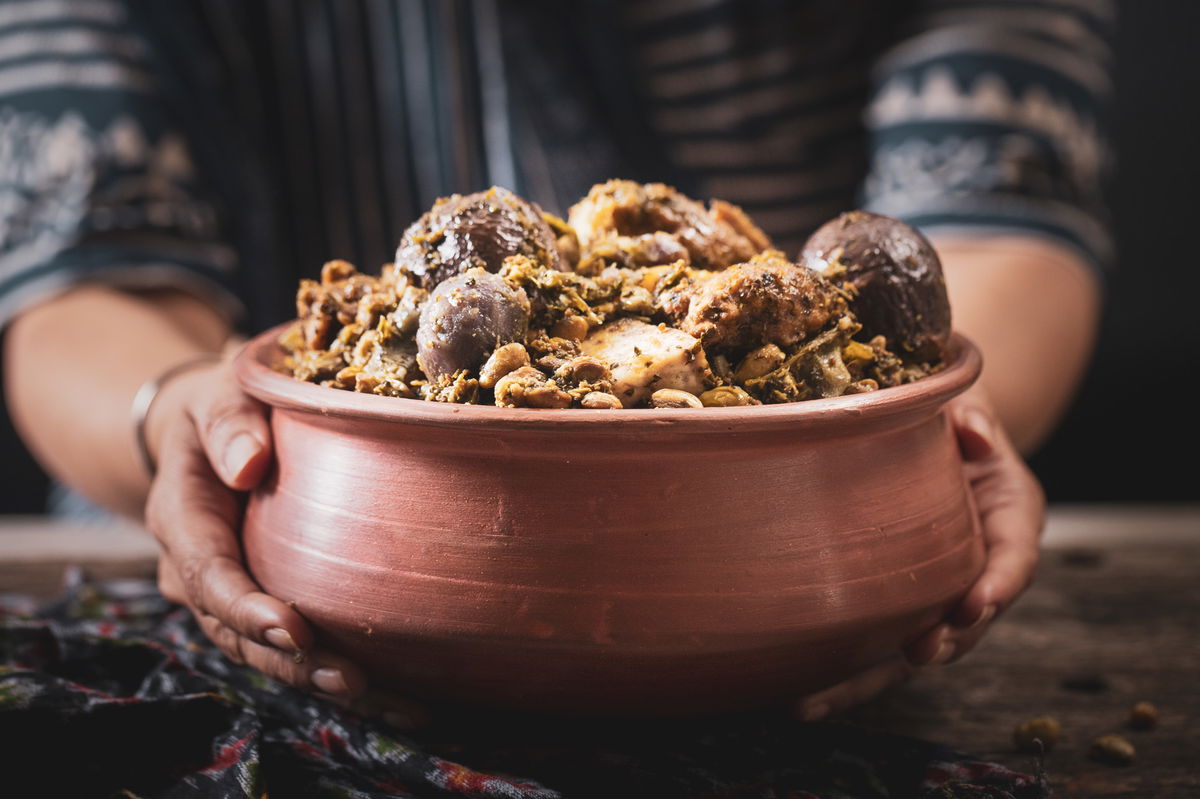
A Dish Built on Generations
In Gujarat, Undhiyu is more than just a mixed vegetable casserole, it is a family event. Some of my favorite childhood memories are from our annual undhiyu parties, hosted by my grandmother and great-uncle. Everyone had a role: the women rolled puris in the kitchen, the men managed the fire outside, and someone always kept sneaking muthiya out of the pot.
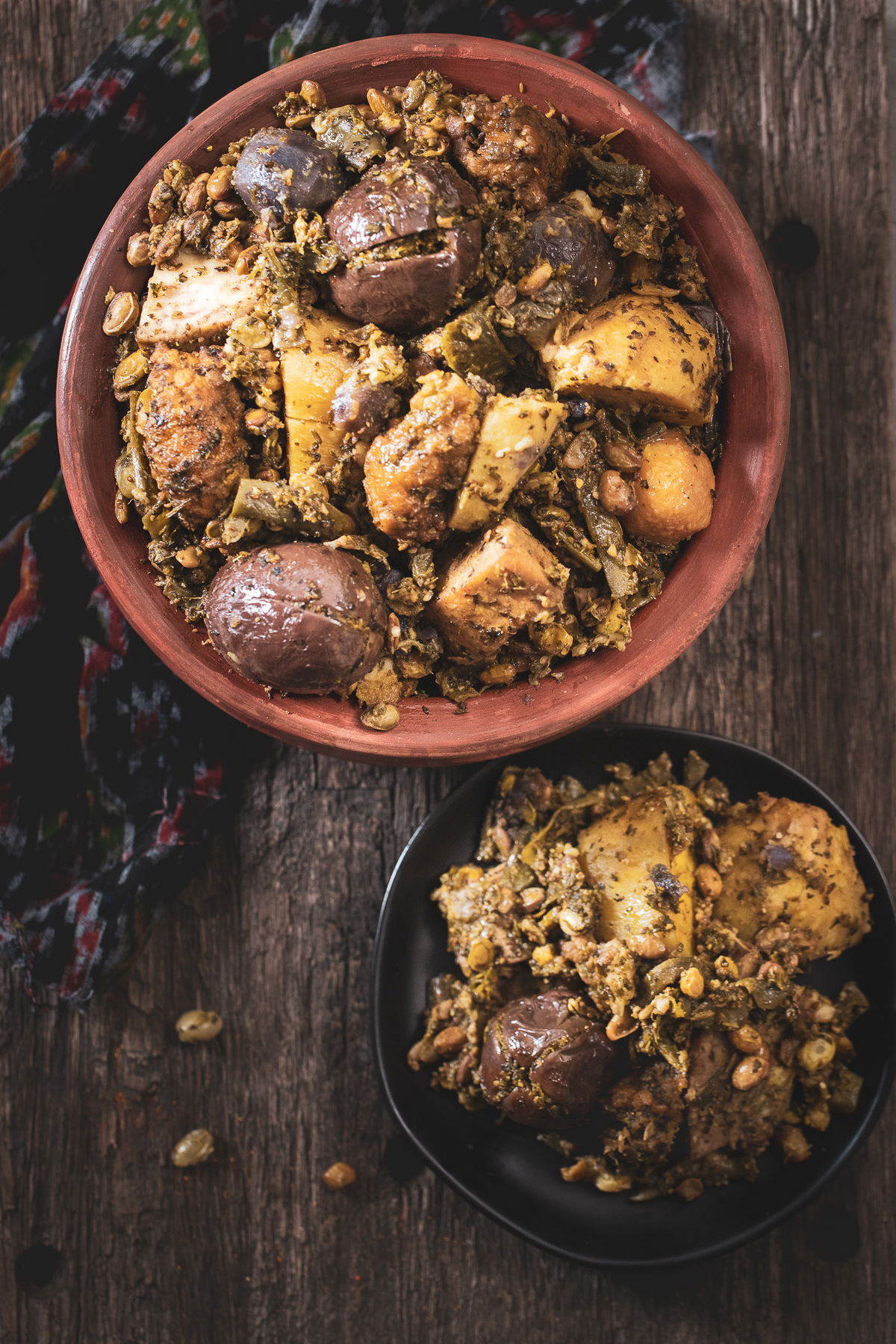
Those gatherings were loud and messy and joyful. They were a celebration of winter, of togetherness, and of this incredibly humble and generous dish that brought us all to the table.
Ingredients
Vegetables
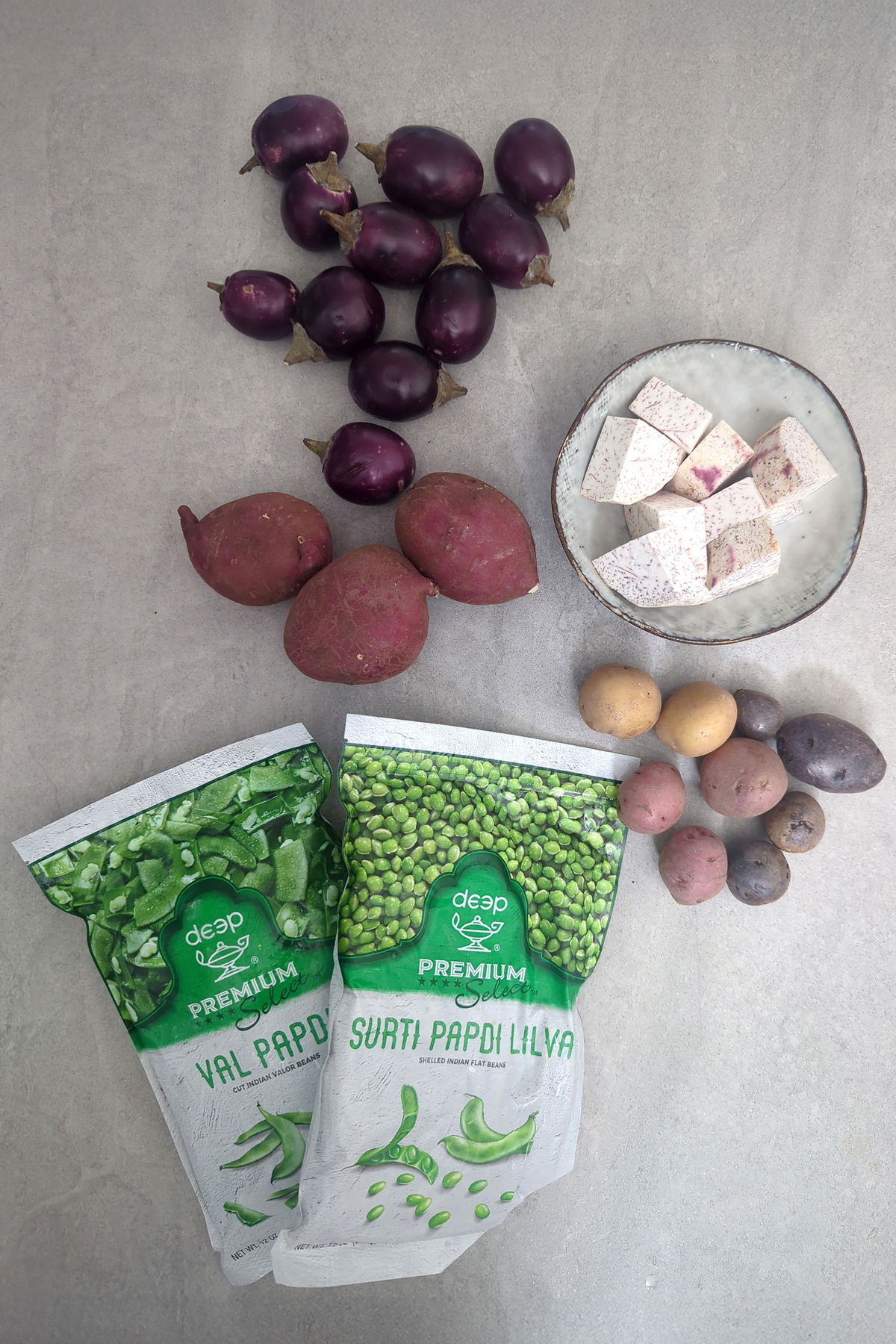
The beauty of undhiyu is in its variety. These winter vegetables each bring their own texture, flavor, and character to the dish.
- White-fleshed sweet potatoes – These are essential in my version. I always use the Japanese kind. They are firmer and have a much more pleasant flavor profile.
- Small globe eggplants (ringan) – The classic choice for stuffing with masala. Globe eggplants are bite sized. If you can’t find them, you can chop up a larger eggplant instead.
- Small white or mixed-color potatoes – Optional, but I sometimes throw in a few. The purple ones add nice color. Growing up, we actually preferred just sweet potatoes and used to ask my mom to skip these.
- Plantain – A traditional ingredient I often skip. It adds body and sweetness. Look for one that is ripe but not soft.
- Taro root (kand or ube) – Earthy, creamy, and one of my favorite parts of undhiyu. I love the ones with purple streaks. This is the root of the same plant used in patra, another beloved Gujarati dish.
- Frozen papdi (Surti and/or val) – I always use a mix. Surti papdi is traditional in Surti Undhiyu, but tends to be just the papdi beans. I also love the fleshy papadi pods and often use val papdi instead since it includes the pod.
Muthiya (Fenugreek Dumplings)
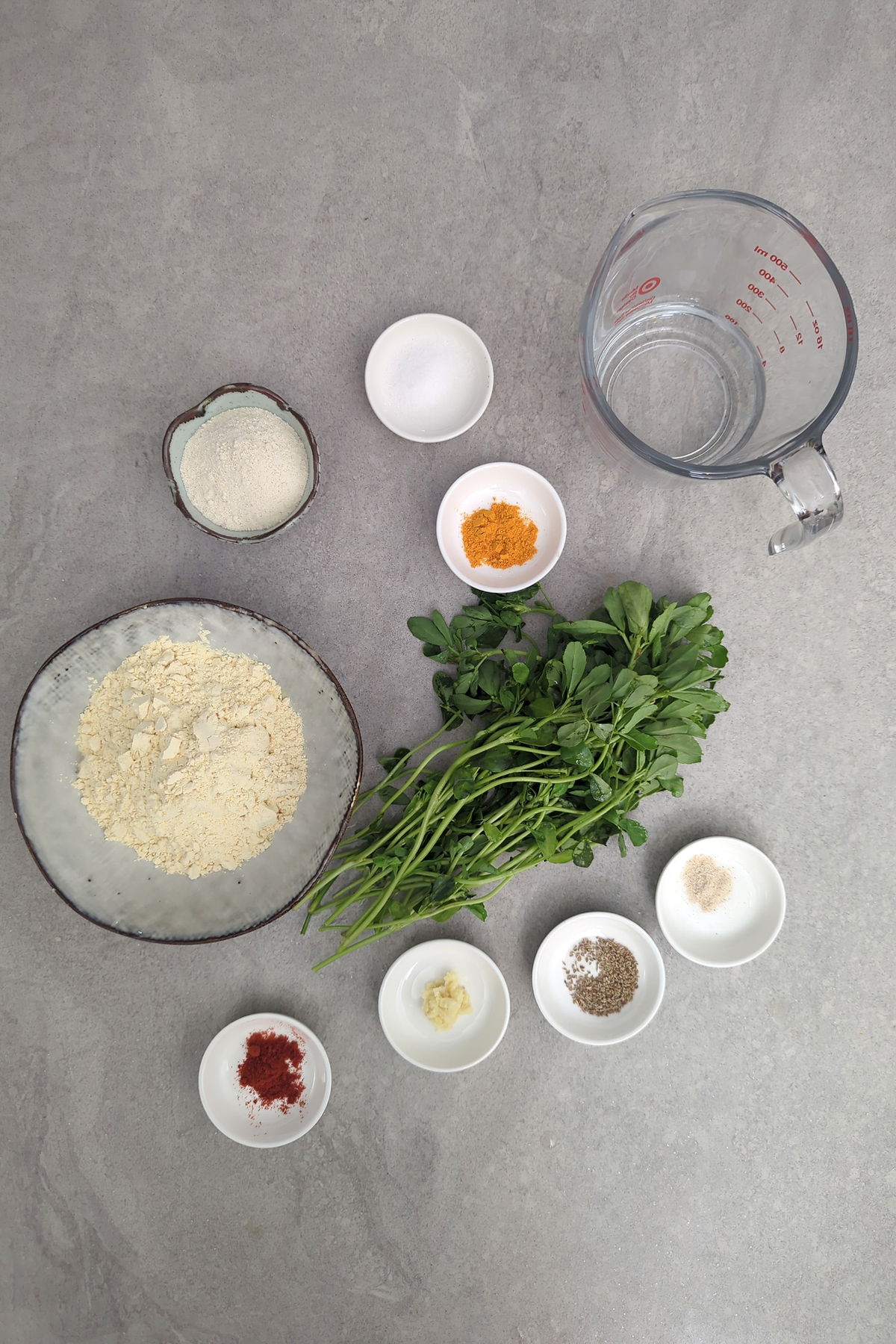
These little dumplings soak up all the masala and bring such warmth to the dish. I make mine with a softer batter. It is easier to fry, and better at absorbing flavor.
- Besan (chickpea flour) – The base of the dumplings. Nutty, dense, and toasty once fried.
- Rava (semolina) – Adds texture and firmness. Without it, the muthiya can get too soft.
- Ajmo (carom seeds) – Ajmo is often added to Gujarati dishes that include papdi. Ajmo adds that unmistakable undhiyu aroma.
- Turmeric & red chili powder – Basic Gujarati pantry spices that bring color and warmth.
- Hing (asafoetida) – Just a pinch brings out savory depth and aids with digestion, especially with beans.
- Salt – As always, to taste.
- Ginger-garlic paste – Adds that sharp bite that balances the sweet vegetables.
- Methi (fenugreek leaves) – The soul of the muthiya. Slightly bitter, deeply flavorful. Fresh or frozen both work. I use whatever I have.
Green Masala

This masala is what ties everything together. It’s not a chutney—it’s a rough, aromatic paste that infuses every bite with fresh, herbal, spicy depth.
- Cilantro – Use the stems and leaves. This is the body of the masala, so you want it fresh and vibrant.
- Garlic – Yes, a lot of garlic. My family’s undhiyu is unapologetically garlicky.
- Green chilies – I like Serranos for their consistency, but any green chili will do. Adjust the heat to your taste.
- Dhana jeeru (ground coriander and cumin) – This pre-blended spice is a Gujarati staple. Toasted and ground fresh if you can.
- Salt – Essential here, since this masala seasons every layer.
- Ajmo (carom seeds) – Again! It belongs both in the dumplings and the masala.
- Hing (asafoetida) – Just a little. Helps balance the richness of the dish.
Why I Love This Version
- I go heavy on muthiya, made with a soft batter dropped into oil, not shaped by hand. I find this process so much simpler and these muthiya absorb the flavors of the masala so well.
- I like to use val papdi, papdi with the pods. You can use surti papdi if you prefer, or a mix of the two.
- I use lots of garlic in the green masala, because that’s how my mom made it, and it is delicious
Recipe
Surti Undhiyu (Instant Pot Method)
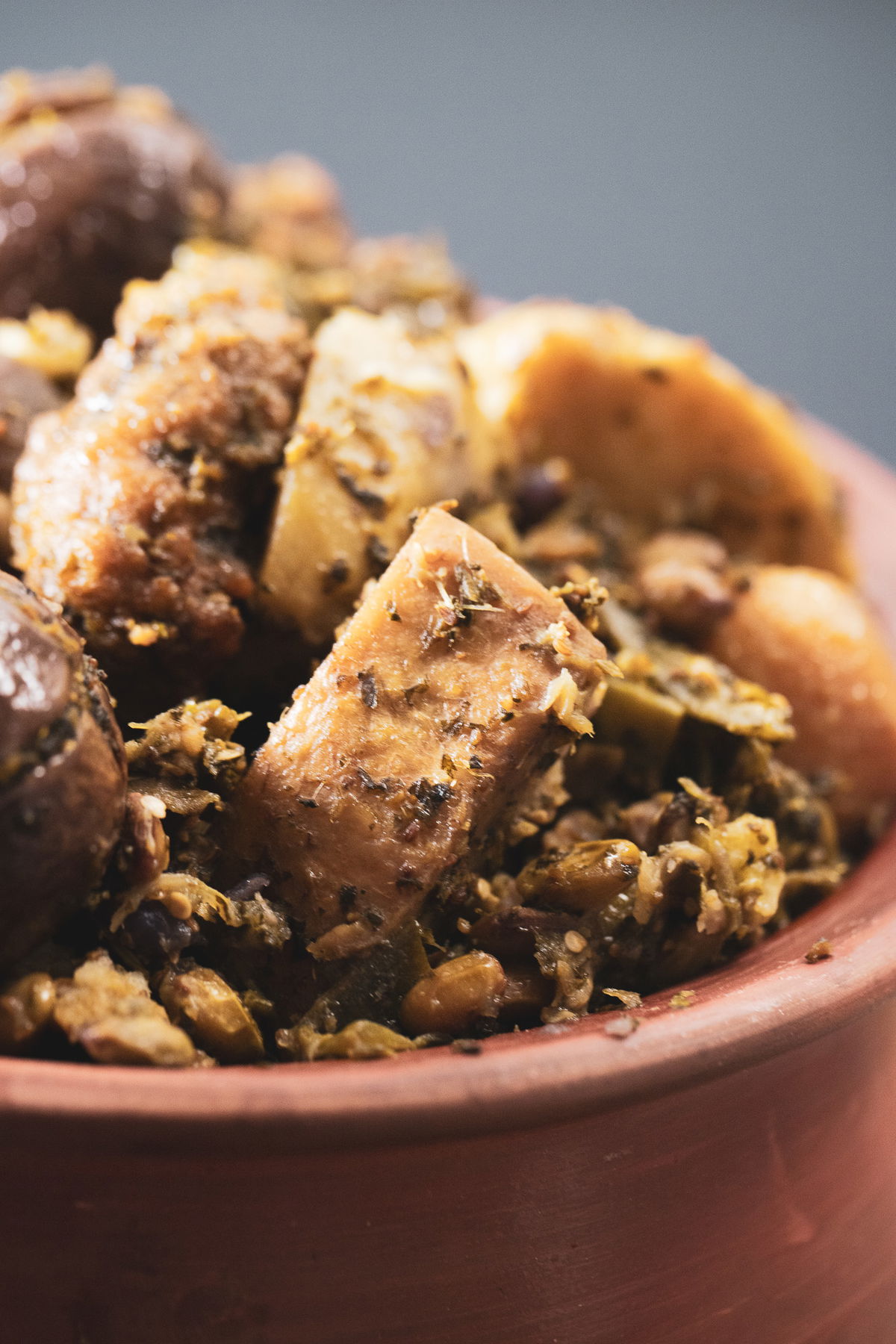
Ingredients
Vegetables
- 2 large white-fleshed sweet potatoes (~500g, peeled and cut into chunks)
- 12 small globe eggplants (ringan, slit crosswise ¾ of the way down)
- 8 small white or mixed-color potatoes (peeled)
- 250 g taro root (kand or ube (optional), peeled and chunked (if using, cut sweet potato quantity into half))
- 2 packets (11 oz each frozen papdi (Surti papdi and/or val papdi), thawed in warm water)
Muthiya (Fenugreek Dumplings)
- 3/4 cup besan (chickpea flour)
- 3 Tbsp rava (semolina)
- 1/4 tsp ajmo (carom seeds)
- 1/4 tsp turmeric
- 1/4 tsp red chili powder
- 1/8 tsp hing (asafoetida)
- 1/2 tsp salt (or to taste)
- 1/2 tsp ginger-garlic paste
- 3 Tbsp chopped frozen methi (fenugreek leaves; ½ cup if using fresh)
- 1/2 cup water
- 3 cups Oil for deep frying
Green Masala
- 3 bunches cilantro (washed, stems included)
- 20 garlic cloves
- 2 –4 green chilies (Serrano preferred)
- 6 Tbsp dhana jeeru (ground coriander-cumin mix)
- 2 tsp salt (or to taste)
- 2 tsp ajmo (carom seeds)
- 1/2 tsp hing (asafoetida)
Tempering (Vaghar)
- 3/4 cup avocado or peanut oil
- 4 tsp ajmo (carom seeds)
- 1/4 tsp hing (asafoetida)
Instructions
Make the Muthiya
- In a bowl, combine besan, rava, ajmo, hing, turmeric, chili, salt, and methi.
- Add enough water to make a thick, sticky batter (not dough). Mix in ginger-garlic paste.
- Heat oil to medium. Test a small drop. It is ready if it rises and sizzles within seconds.
- Use a fork to scoop and drop small dollops into the frying oil. Carefully stir so it fries evenly on all sides. Fry until golden.
- Drain on paper towels.
Make the Green Masala
- In a food processor, add roughly chopped cilantro (stems are okay), garlic, green chilies (adjust heat level), salt, ajmo, hing, and dhana jeeru.
- Pulse until it becomes a finely chopped mixture, not a paste.
Prep the Veggies
- Eggplant: Cut 2 cross slits ¾ down, gently stuff with masala.
- Sweet potatoes and potatoes: Peel, cut into chunks, optionally slit and stuff or just toss with masala. Be sure that the total weight of all starchy vegetables does not exceed 800 g, which includes taro and plantain, if using.
- Taro and plantain: Peel, cut, and coat with masala.
- Muthiya: Poke holes or split a few to help absorb masala.
Cook in Instant Pot
- Turn on Sauté mode. Add oil, heat until shimmering. Add ajmo and hing. Sizzle 20 seconds.
- Add thawed papdi. Sauté for about 2 minutes.
- Add the remaining green masala, stir well, and cook for 1–2 minutes if needed to reduce moisture slightly.
- Add: Root vegetables first (sweet potato, potato, taro). Then add muthiya. Give it a good stir. Then add stuffed eggplants last (they’re most fragile).
- Pour ¾ cup water around the edges, stir gently.
- Pressure Cook: Seal the Instant Pot lid. Set to Pressure Cook on High for 30 minutes. Let natural release for 10 minutes, then manually release the rest.
- Serve: Garnish with fresh cilantro. Serve hot with puri, paratha, or roti.
Notes:
- The muthiya batter is intentionally softer than traditional, giving you lighter, juicier dumplings that absorb masala better.
- You can mix val papdi and Surti papdi, or use one based on preference.
- Taro adds a delicious earthy sweetness but can be skipped if unavailable.
- Don’t blend the masala into a paste. It needs texture.
- Plantains are also commonly added as a starchy vegetable. You can use a large plantain, cut into similarly sized pieces, and reduce your root vegetables to make room for them.
Video

